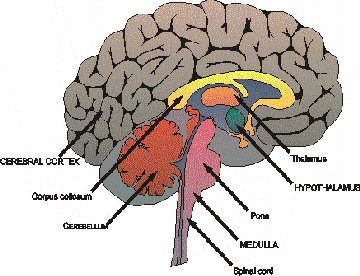- What is Lymphoma of the Brain
- Statistics on Lymphoma of the Brain
- Risk Factors for Lymphoma of the Brain
- Progression of Lymphoma of the Brain
- Symptoms of Lymphoma of the Brain
- Clinical Examination of Lymphoma of the Brain
- How is Lymphoma of the Brain Diagnosed?
- Prognosis of Lymphoma of the Brain
- How is Lymphoma of the Brain Treated?
- Lymphoma of the Brain References
What is Lymphoma of the Brain

The brain is the control centre for the body. It is comprised of millions of individual nerve cells, which are all interconnected. It is located at the top of the spinal cord and is encased in hard bone. Individual nerves emerge from the brain to work the muscles and organs contained within the head. These are called cranial nerves.
The brain itself is divided into 2 sides and each side contains a number of lobes. The frontal lobes control some functions such as memory and learned behaviour, together with some speech functions. The parietal and temporal lobes contain the control centre for movement and sensation on the opposite side of the body. The occipital, located at the back, interprets visual signals from the eyes and is therefore responsible for sight. Located underneath the occipital lobes is the cerebellum, which controls balance and coordination on the same side of the body.
The brain stem is responsible for automatic functions such as breathing.
Statistics on Lymphoma of the Brain
Primary cerebral lymphomas are rare. They represent less than 1% of all CNS tumours. It can occur at any age but is more common in the elderly. It affects males and females equally. Geographically the disease is found worldwide.
Risk Factors for Lymphoma of the Brain
Predisposing factors include:
- Exposure to ionising radiation.
- Infection with the Epstein Barr virus (which is known to be a causative factor for a variety of lymphomas)
- Immunodeficiency (including AIDS and following organ transplantation).
Progression of Lymphoma of the Brain
This type of tumour spreads by infiltration of the cerebrospinal fluid and seeding within the central nervous system. In less than 10% of patients distant metastases occur to sites such as the viscera, bones and soft tissues.
How is Lymphoma of the Brain Diagnosed?
General investigations may show anaemia of chronic disease or evidence of systemic lymphoma if the disease is due to metastatic deposits.
Prognosis of Lymphoma of the Brain
Primary cerebral lymphoma may be cured by radiotherapy and chemotherapy.
Unfortunately, many of these tumours are incurable and relapse occurs between 6 months and 2 years following initial treatment.
Relapsed or recurrent disease generally has a very poor prognosis often with death within a few months.
How is Lymphoma of the Brain Treated?
Following confirmation of the histology by biopsy, usual treatment of this disease is with radiotherapy either alone or combined with chemotherapy and corticosteroids.
Chemotherapy protocols include:
1) PCV
– Lomustine (CCNU) 110mg/m2 oral day 1 (capsules are 100, 40, 10mg)
– Vincristine 1.4mg/m2 ( max 2 mg) I.V. Day 1
– Procarbazine 60mg/m2 oral Days 8 to 21 (capsules are 50 mg) (repeat every 4 weeks)
2) Temozolamide 200 mg/m2/day p.o. for 5 days every 4 weeks if no prior chemotherapy, 150 mg/m2/day p.o. for 5 days every 4 weeks if prior chemotherapy.
3) Thalidomide given as a single agent or in combination with chemotherapy (needs ethics committee and SA Govt issued license to prescribe)
100 mg/day starting dose, increase by 100 mg/day each week until 500 mg/day p.o.
Surgery in lymphoma is usually limited to sampling a biopsy in order for a tissue diagnosis to be established.
The symptoms that may require attention are headache, which can be treated with standard analgesics. Headaches should be considered as a visceral pain.
Other symptoms that may require attention are those resulting from the neurological deficits associated with the tumour and the neurogenic pain from compressed nerve tissue. Patients with significant neurological deficits are best managed by a specialised neurological team using a multidisciplinary approach including physiotherapy, occupational therapy, nursing and medical practitioners.
Improvement in symptoms is an important measurement. Specific monitoring may be by serial imaging of the brain and spinal cord eg with CT scans or MRI.
Problems with function can be assisted greatly by Physiotherapists and Occupational Therapists.
A variety of equipment is available for the neuroligically impaired to make life a little easier.
Lymphoma of the Brain References
- MEDLINE Plus
- Greenberg JO: Cerebral lymphoma. In: Adams RD. Neuroimaging: A Companion to Adams and Victor’s Principles of Neurology. McGraw-Hill; 1995: 418-9.
- Hochberg FH, Miller DC: Primary central nervous system lymphoma. J Neurosurg 1988 Jun; 68(6): 835-53
- Nasir S, DeAngelis LM: Update on the management of primary CNS lymphoma. Oncology (Huntingt) 2000 Feb; 14(2): 228-34; discussion 237-42, 244
All content and media on the HealthEngine Blog is created and published online for informational purposes only. It is not intended to be a substitute for professional medical advice and should not be relied on as health or personal advice. Always seek the guidance of your doctor or other qualified health professional with any questions you may have regarding your health or a medical condition. Never disregard the advice of a medical professional, or delay in seeking it because of something you have read on this Website. If you think you may have a medical emergency, call your doctor, go to the nearest hospital emergency department, or call the emergency services immediately.







